Oldtimer picture gallery. Cars. Opel-Olympia OL38.
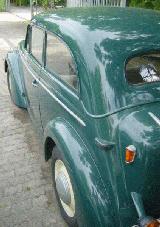

 Opel-Olympia OL38 (Model 3500)
Opel-Olympia OL38 (Model 3500)
Years of production: XII 1937 - X 1940,
1943 (further development models in
1947-1949, 1950-1951, 1951-1953,
1951 from the rear, van)
Overall production: 87214 units (pre-1945)
4x2 4-seat chassis-less body
Body modifications
(prices in Reichsmarks):
2-door 4-light limousine (body symbol - LZ, price - 2675 RM) (most
popular),
4-door 6-light limousine (LV, 2950 RM),
2-door 4-light cabriolimousine (CL, 2750 RM) (17602 built),


 Engine: 37hp/3400rpm, 4-cyl 4-stroke
Engine: 37hp/3400rpm, 4-cyl 4-stroke
OHV, 1488cc
Length: 4020mm, width: 1500mm (by III
1938 Opel-book - 1525mm) (since 1939
- 1530mm), height: 1520mm (by III 1938
Opel-book - already 1570mm) (since
1939 - 1570mm)
Wheelbase: 2430mm, road clearance: 195mm
Front wheel track: 1105mm; toe-in: 2,4mm; camber: 0o47'; caster: 12,6mm on special Opel instrument
Rear track: 1250mm


 Turning diameter:
Turning diameter:
11,5 m (right), 11,4 m (left)
Bore/Stroke: 80/74 mm
Pistons type and material: EC,
Autothermik
Cold clearance between tappet and valve
stem: intake - 0,2mm, exhaust - 0,3mm
Compression ratio: 6 : 1
Carburettor: Opel, downdraft vertical, 3 types


 Dimensions (in mm and conditional units):
Dimensions (in mm and conditional units):
diffusor - 21/21/21mm;
main jet - 44/44/44cu;
sprayer jet - 50/46/46cu;
idling jet (sprayer tube/calibrated hole) -
75/42cu/70/36cu/75/32cu;
accelerator jet - 50/50/50cu;
between float's top and bottom of float chamber lid - 12/12/12mm
Air filter: oil bath type (metal shavings, moisturized by oil)


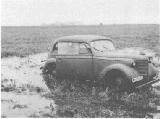 Ignition system: battery (Bosch, 6V),
Ignition system: battery (Bosch, 6V),
battery capacity - 75 A*h
Interrupter-distributor type:
VE4-TK6/1 or VE4-ALS 262;
contact clearance: 0,35 - 0,45 mm
Generator type and power:
DE/6AR12; 90W
Starter type and power: CG 0.6/6BRS 37P; 0,6hp
Spark plugs type: W 145/0; 14mm; electrode clearance: 0,7 - 0,8 mm


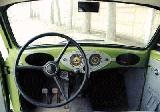 Cylinder firing order: 1-3-4-2
Cylinder firing order: 1-3-4-2
Clutch:
dry single plate with a spring dampers
Clutch pedal free run: 25-30mm
Gearbox: 4 forward, 1 back
Ratios: I - 3,91; II - 2,47; III - 1,49;
IV - 1,00; back - 4,21
Differential ratio: 4.56, bevel gear with spiral tooth
Front suspension: independent, Dubonnet type


 Rear suspension: whole axis of Banjo type
Rear suspension: whole axis of Banjo type
with longitudinal semielliptical springs
Hydraulical all-wheels shoe brakes
Weight: 896kg (since 1939 - 903kg)
Maximal speed: 112 km/h
Tyres: 5,00-16 inches
Tyre pressures (atmospheres):
front - 1,6, rear - 1,7 (2 seating) and 2,0 (4 seating)


 Fuel tank capacity: 35+5 Ltr (by 1938 description - 28 Ltr)
Fuel tank capacity: 35+5 Ltr (by 1938 description - 28 Ltr)
Fuel consumption: 9,9 L/100km
Cooling system capacity: 9,0 L
Oil carter capacity: engine - 3,2 L;
gearbox - 0,70 L; differential - 1,50 L
Rear sidewindows were turnable for ventilation on 2-door modifications.
Pre-index of chassis and engine No (Opel data):
Year Chassis numbers Engine numbers
1938 OL-38-1 to OL-38-41740 38-1 to 38-41471
1939 OL-38-41741 to OL-38-80352 39-1 to 39-38605
1940 OL-38-80353 to OL-38-87272 40-1 to 40-6868
Productionnumbers by Eckhart Bartels:
Year 1937 1938 1939 1940 1941 1942 1943 Total
OL38 399 46666 36954 3193 - - 2 87214 (incl. 17602 cabriolimousines)


 But there are exclusions in serial numbers
But there are exclusions in serial numbers
by year table. Look at this factory plate
(Chassis OL38-46503), sent by Vitaly
Samoylik from Tyumen, Russia. (Chassis
OL38-44762 was also dated 1938.).
Or look at this plate. On the other hand
2nd table is not very correct too, because serial number of my car is OL38-46746 (Motor Nr. 39-5241), but it is dated
1939 already.


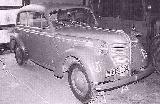 In 1938 Opel-Olympia, model 13237
In 1938 Opel-Olympia, model 13237
was seriously modified and has got index
OL38.
From outside Opel-Olympia OL38 is
very similar to Opel-Kadett K38.
Their outer difference is in:
bonnet: K38 - side-opening wing-type lids, OL38 - alligator-mouth opening lid,
bonnet louvres: K38 - 2 rows x 4 slots inside moulding, OL38 - row of shell-shape festoons under the moulding,


 grill: K38 - 5 moulding ribs, OL38 - 6
grill: K38 - 5 moulding ribs, OL38 - 6
moulding ribs (some 4-door Limousine
and post-war cars have mouldings on
every rib).
rear window: edges of OL38 window
slightly dip down, under the window
horizontal moulding lines.
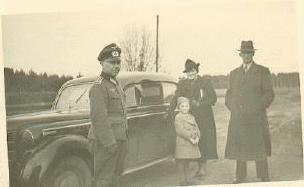

 Names of factory paints:
Names of factory paints:
Schwarz (black), Marinetiefblau (sea
depth blue), Hellsandgrau (light
sandish-grey), Dunkelgrau (dark grey),
Feldgrau (German khaki, which is more
grey, than green), Atlantikgruen (Atlantic green), Mittelblau (middle blue), Dunkelrot (dark red),
Opelbeige, Hellgrau (light grey), Mittelgruen (middle green), Graubeige (greyish-beige).


 Some outer changes by serial numbers:
Some outer changes by serial numbers:
Since Fahrgestell Nr. OL38-6561 - more
wide turn side flags
Since Fahrgestell Nr. OL38-16634 - new
"Olympia" front side molding flags. On the
old version "Olympia" letters began slightly not from the front edge.
Since Fahrgestell Nr. OL38-49300 (on some cars from OL38-48393) - front "Opel" badge lost letters "Opel", but this word


 appeared just above, on the front point of the bonnet. Plus front bonnet moldings have got more complicated form.
appeared just above, on the front point of the bonnet. Plus front bonnet moldings have got more complicated form.
Since Fahrgestell Nr. OL38-64019 (on some cars from OL38-62704) - rear side lights appeared over rear wings.
Photos are from:
Panzermuseum Munster, Germany,
Opel,
Autoclassic magazine, Hungary,
Martin Vorwahl, collector of oldtimer photos, Oldenburg, Germany,
W.Schmarbeck/B.Fischer "Alle Opel Automobile", 1989, Motorbuch Verlag Stuttgart,
Marcus Dahlqvist hemsida, Sweden (in Swedish/English).
Visit this site - there are many very good photos of old Opel cars.
Reinhard Frank "Personenwagen der Wehrmacht", PODZUN-PALLAS.
Eckhart Bartels "Opel Fahrzeug-Chronik 1887-2000", Podszun, 2000.
1951 Olympia (59k) and 30k from rear is courtesy of Richard Guay, the owner of the car, Maine, USA.
Tino Prat (Barcelona, Spain) sent a picture of 1940 Olympia 2-door limousine, which was Tino's father (behind the car) 1st car in 1940 (grandfather is sitting in the car)
mobile.de,
eBay Deutschland,
Opel Olympia OL38-81320,
Aleksej Popov (Riga),
Aleksei Rjazancev (Sankt-Peterburg, AVTORETRO (in Russian)).

Entrance Gallery Cars Opel Sale Links
Last updated 8 III 2003.
Andrei Bogomolov, owner of 1939 Opel Olympia LZ, Farhgestell nr. OL38-46746, Motor Nr. 39-5241.
ab@iki.rssi.ru





 Engine: 37hp/3400rpm, 4-cyl 4-stroke
Engine: 37hp/3400rpm, 4-cyl 4-stroke

 Turning diameter:
Turning diameter:

 Dimensions (in mm and conditional units):
Dimensions (in mm and conditional units):

 Ignition system: battery (Bosch, 6V),
Ignition system: battery (Bosch, 6V),

 Cylinder firing order: 1-3-4-2
Cylinder firing order: 1-3-4-2

 Rear suspension: whole axis of Banjo type
Rear suspension: whole axis of Banjo type

 Fuel tank capacity: 35+5 Ltr (by 1938 description - 28 Ltr)
Fuel tank capacity: 35+5 Ltr (by 1938 description - 28 Ltr)

 But there are exclusions in serial numbers
But there are exclusions in serial numbers

 In 1938 Opel-Olympia, model 13237
In 1938 Opel-Olympia, model 13237

 grill: K38 - 5 moulding ribs, OL38 - 6
grill: K38 - 5 moulding ribs, OL38 - 6

 Names of factory paints:
Names of factory paints:

 Some outer changes by serial numbers:
Some outer changes by serial numbers:

 appeared just above, on the front point of the bonnet. Plus front bonnet moldings have got more complicated form.
appeared just above, on the front point of the bonnet. Plus front bonnet moldings have got more complicated form.